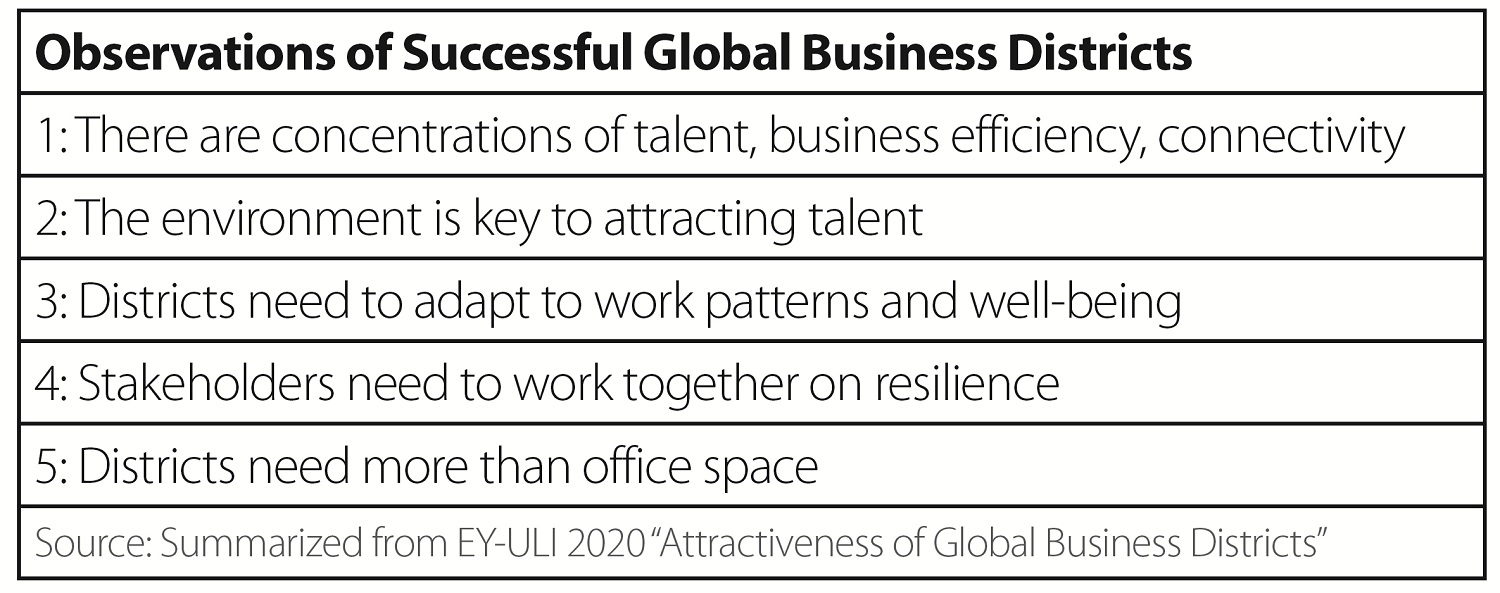What Makes an Attractive Business District?
是什么使得一个商业区变得有吸引力
By Michael Hart
 As we near the end of 2020, many of us are reflecting on how our families and businesses have fared amidst the chaos of COVID-19 and the interruption it has caused. On one level, while Europe and the US continue to see additional outbreaks, in China things appear to be headed back to normal. Children are returning to school, and cinemas and some tourist spots have reopened, but at another level, our cities and business districts have been severely impacted and there is no quick return to normal for them. One can see the impacts particularly clearly in malls where previously busy shops have closed, or in office buildings where previously occupied floors are now vacant. One question will be how quickly these business districts can recover, and which of the many business districts are likely to prosper in the longer term.
As we near the end of 2020, many of us are reflecting on how our families and businesses have fared amidst the chaos of COVID-19 and the interruption it has caused. On one level, while Europe and the US continue to see additional outbreaks, in China things appear to be headed back to normal. Children are returning to school, and cinemas and some tourist spots have reopened, but at another level, our cities and business districts have been severely impacted and there is no quick return to normal for them. One can see the impacts particularly clearly in malls where previously busy shops have closed, or in office buildings where previously occupied floors are now vacant. One question will be how quickly these business districts can recover, and which of the many business districts are likely to prosper in the longer term.
快到2020年年底时,我们中的许多人都在反思。在新冠疫情造成的影响之下,我们的家庭和企业应如何发展。一方面,欧美的疫情继续肆虐;而在中国,情况似乎已恢复正常。学生重返学校,电影院和一些旅游景点已经重新开放。但在另一个层次上,我们的城市和商业区仍然受到了严重的影响;它们无法迅速恢复正常。社会上有着非常多倒闭的商店,就能够清楚地说明这一点。现在的问题是,这些商业区需要多长时间才能恢复?这么多商业区,哪个可能长期繁荣?本文在分析当今商业区状况的同时,也教导打架如何建立一个成熟的,吸引人的,客流量大的商业区。
Building an Attractive Business District
 Although not written specifically for the recent pandemic, an ]annual report published by Ernst and Young (EY) and Urban Land Institute (ULI), “The Attractive of Global Business Districts”, has some timely lessons. The 2020 report, which was published in May, gives a nod to the current crisis, but is aimed more specifically at what makes one district or city more successful than another in the long term. And while the authors were looking at what they called GBDs, Global Business Districts, that doesn’t mean there isn’t something we can learn from the report. There are plenty of lessons to be gleaned for the long term and also some concepts to help us predict which business district will prosper in the near term. The report can also give government officials some ideas to focus on for planning or revamping business districts.
Although not written specifically for the recent pandemic, an ]annual report published by Ernst and Young (EY) and Urban Land Institute (ULI), “The Attractive of Global Business Districts”, has some timely lessons. The 2020 report, which was published in May, gives a nod to the current crisis, but is aimed more specifically at what makes one district or city more successful than another in the long term. And while the authors were looking at what they called GBDs, Global Business Districts, that doesn’t mean there isn’t something we can learn from the report. There are plenty of lessons to be gleaned for the long term and also some concepts to help us predict which business district will prosper in the near term. The report can also give government officials some ideas to focus on for planning or revamping business districts.
Observations from Successful Global Business Districts
The 40-plus page report highlights five observations about long term trends transforming business districts. I’ve simplified them here, hopefully without losing too much of their key message.
 Put simply, building a successful business district is about much more than buildings. In fact, buildings aren’t nearly enough. Creating a successful business environment depends upon people. How do cities attract them, allow them to work and interact efficiently? We also need to keep in mind that people are changing the ways and places where they want to do work. The report also notes that there is a shared burden for ensuring that the physical environment is clean and healthy and that it can be sustainable. A number of leading global cities have in recent years suffered from weather-related disasters. Cities and business districts need to be thinking about these challenges, and city governments, as well as real estate developers, share the responsibility for making sure the built environment can withstand such events.
Put simply, building a successful business district is about much more than buildings. In fact, buildings aren’t nearly enough. Creating a successful business environment depends upon people. How do cities attract them, allow them to work and interact efficiently? We also need to keep in mind that people are changing the ways and places where they want to do work. The report also notes that there is a shared burden for ensuring that the physical environment is clean and healthy and that it can be sustainable. A number of leading global cities have in recent years suffered from weather-related disasters. Cities and business districts need to be thinking about these challenges, and city governments, as well as real estate developers, share the responsibility for making sure the built environment can withstand such events.
Defining an Attractive City or Business District
 The ULI and EY report went on to highlight and explain five factors that make a business district attractive. In some cases, there isn’t much a planner or landlord can do. However, in other cases, they should keep in mind that tenants have choices about where to go, and aim for lighter regulation and planning when possible. Below, I’ve listed the factors highlighted in the report and then added my own interpretation.
The ULI and EY report went on to highlight and explain five factors that make a business district attractive. In some cases, there isn’t much a planner or landlord can do. However, in other cases, they should keep in mind that tenants have choices about where to go, and aim for lighter regulation and planning when possible. Below, I’ve listed the factors highlighted in the report and then added my own interpretation.
Factor 1: Ability to attract and retail talent
The war for talent is going to be a key ongoing battle for success in cities and business districts for the foreseeable future. Whoever makes it easy to attract talent, whether that be computer programmers, foreign language speakers or finance experts, stands a good chance of winning the talent battle and as a result will have a vibrant business cluster resulting in full buildings and good tax revenue. One catch is that cost of living is a big concern. I’ve heard a lot of pitches from local government to try and bring in talent, but it’s been a long time since I heard one mentioning cheap apartments for skilled workers. Perhaps the best way to fill office buildings is to offer nearby cheap apartments to qualified workers. China has recently worked to loosen restrictions on qualified workers, but this is an area that deserves more study. One measure for Tianjin might be how many local university graduates are still in Tianjin after a year and are gainfully employed.
Factor 2: Proximity to Markets, Customers and Partners
This factor is one that I find landlords and government officials often just don’t understand. Companies often choose to be near their customers or partners, so if you land one “anchor” type company, they will attract others. The problem is, we often don’t understand well enough what that anchor is. I have heard some landlords say they only want one industry, for example banks. This illustrates a lack of understanding about how businesses cluster. Most people don’t want to be right next to their competitors, but they will be happy to be near their service providers. In China, for example, there have traditionally been heavy restrictions on foreign law firms that kept them concentrated in Beijing and Shanghai. Guess who else will stay in those cities? It will be their customers, such as securities firms and multinational corporations. Likewise, one of the benefits of living in Tianjin has long been a wide variety of Korean and Japanese restaurants. Recently one of my favourite Korean restaurants closed. Why? Because their customers left. I hope this isn’t the beginning of a long unwinding of a complex cluster of businesses and their associated partners that helped to make our city vibrant.
 Factor 3: Quality of the Urban Environment
Factor 3: Quality of the Urban Environment
Singapore, Chicago, New York and Sydney rank high in the EY-ULI report for quality of life. One way they got there was by having loads of restaurants, cultural options such as art galleries, theatres and sport events. The funny thing, of course, is that if a city encourages these types of cultural amenities, the residents will benefit whether they attract new companies or not. And the truth is, investing in cultural events is one of the easiest ways to improve the city image, encourage tourism, increase the liveability and even create new service sector jobs. To me, this is an obvious place for cities to encourage investment. I think the completion of the new Tianjin Juilliard school will bring benefits to the city that none of us had considered. Next, how about moving one of those professional sports teams to play in one of the many stadiums in the heart of the city?
Factor 4: Local and Global Influence
Building local and global influence is one area where Chinese cities seem to be getting things more right than wrong, and Tianjin has had a number of successful examples. The observation from the EY-ULI report is that building transport links like airports and train stations and then holding regional and global events is one way to raise a city’s profile. Tianjin has done this by regularly hosting summer Davos, co-hosting the 2008 Olympic soccer matches and holding important tennis tournaments. More of these types of events will continue to increase the city’s profile and provide events for the local population.
Factor 5: Bespoke and Innovative Real Estate Supply
My summary of this point is that space needs to be flexible, and if it is interesting, all the better. Not every company can work or needs to work in a standard office building. And if there is some historic architecture in a neighbourhood that can be converted into interesting space, all the better. One frustration I have with Tianjin is that there are loads of old, interesting buildings, but often the landlords want to dictate who should use them and how. Governments and landlords should regard the buildings as a canvas and then let the painters paint; in other words, advertise the space as available for lease and let the tenants decide if the building is right for them.
Conclusion
Cities, landlords and businesses are all reeling from the recent COVID outbreak. The last thing on many people’s minds is how to build a successful business district. However, with the business community shrinking, some cities and business districts will be more successful than others at attracting talent and being at the forefront of the recovery. This report from EY-ULI in fact reminds us that there are a handful of impactful strategies and important factors that will set successful business districts apart from the rest. The question is, are we addressing these issues?
 Michael Hart is the Managing Director of Griffin Business Management www.griffinbiz.com a real estate related investment and consulting firm with offices in Tianjin.
Michael Hart is the Managing Director of Griffin Business Management www.griffinbiz.com a real estate related investment and consulting firm with offices in Tianjin.